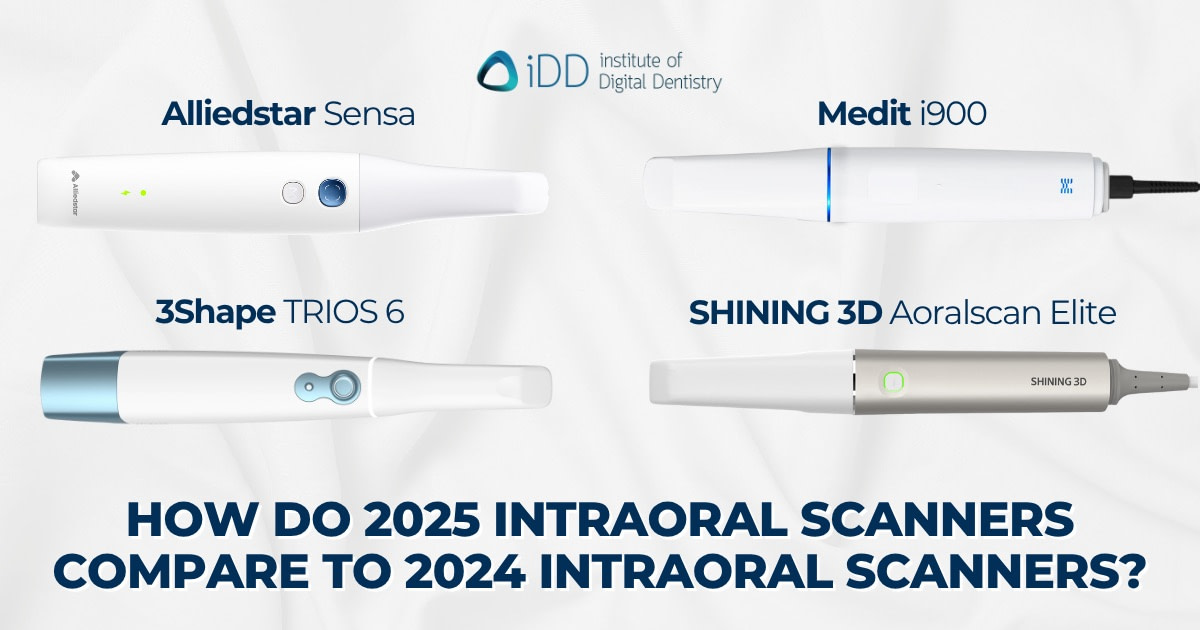In our previous iDD Compares, we looked at Alliedstar’s newest addition to their intraoral (IOS) range, Sensa, which was announced during IDS earlier this year.
Alliedstar was not the only company to launch a new scanner at IDS. 3Shape also had a big launch at the event, introducing its TRIOS 6. That marks two brand new scanners featured at the most anticipated dental expo.
Let’s find out how they compare!
It’s only right that iDD compares these flagship scanners, TRIOS 6 and Sensa, to two of 2024’s flagship scanners, SHINING 3D’s Aoralscan Elite and Medit i900.
Our aim is to provide clinicians with unbiased and objective comparisons based on real usage. We hope that our iDD Compares series can help you understand how these devices perform in actual clinical settings when considering your next IOS investment.
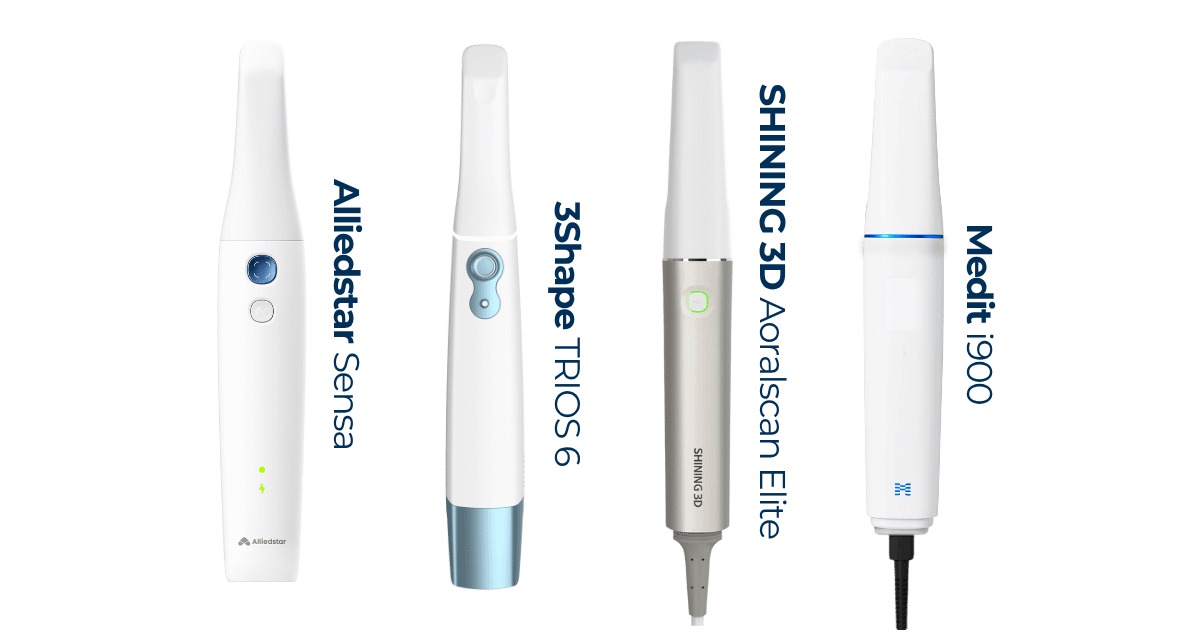
Intraoral Scanners at a Glance
Before diving into the details, let's quickly go over how these scanners compare in terms of key specifications and pricing:
3Shape TRIOS 6
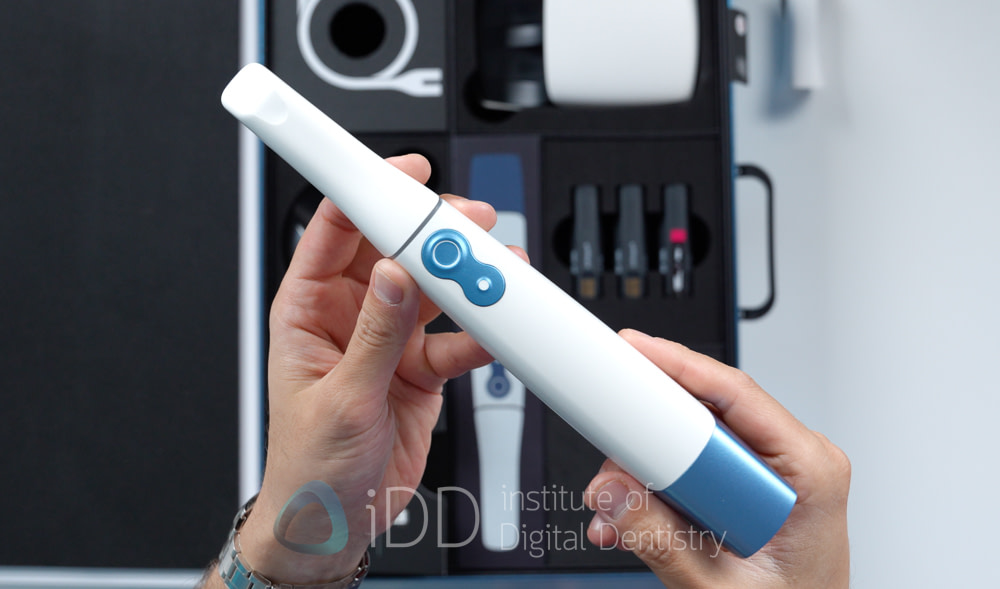
The TRIOS 6 from 3Shape shares the same hardware as its predecessor, TRIOS 5, but with some big software additions - AI diagnostics, TRIOS Dx Plus diagnostic software, and a DentalHealth patient iPhone app that aims to transform the entire value proposition of the TRIOS 6 from digital impressions to comprehensive diagnostics and patient engagement.
- Year: March 2025
- Price (USD): $27,900 USD (+$8,000 USD for MOVE Pro cart)
- Weight: 308g (incl. battery and tip)
- File formats: STL and PLY
- Software Platform: 3Shape Unite, Dx Plus
Alliedstar Sensa

Alliedstar’s new scanner is a complete redesign of its IOS line, moving away from its more economic-looking predecessors to a modern, ergonomic design. The company has rebranded with a new logo and named its flagship scanner "Sensa," which reportedly stands for "Sensational scanning”, moving away for model numbers for their scanners like AS260, 200E etc. This is the companies most ergonomic and premium looking scanners to date.
- Year: March 2025
- Price (USD): $13,995
- Weight: 230g
- File formats: STL, PLY and OBJ
- Software Platform: AS Connect
SHINING 3D Aoralscan Elite
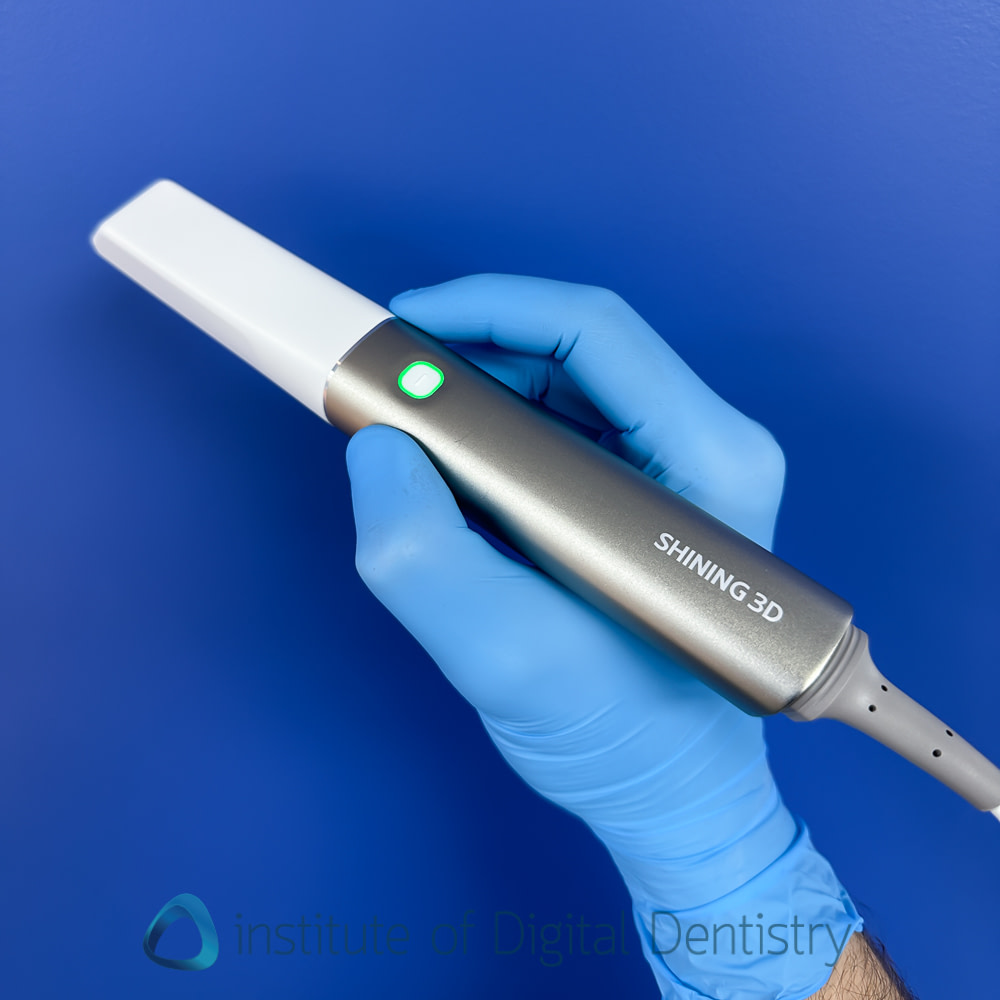
Shining 3D's Aoralscan Elite is iDD’s pick for 2024’s scanner of the year. It is a great all-round scanner and introduced the innovative and game-changing intraoral photogrammetry (IPG) technology, with its coded scan body system enhancing full-arch implant scanning precision.
- Year: September 2024
- Price (USD): $19,999
- Weight: 124g (currently one of the lightest scanners on the market)
- File formats: STL, PLY, OBJ
- Software Platform: SHINING 3D Platform
Medit i900
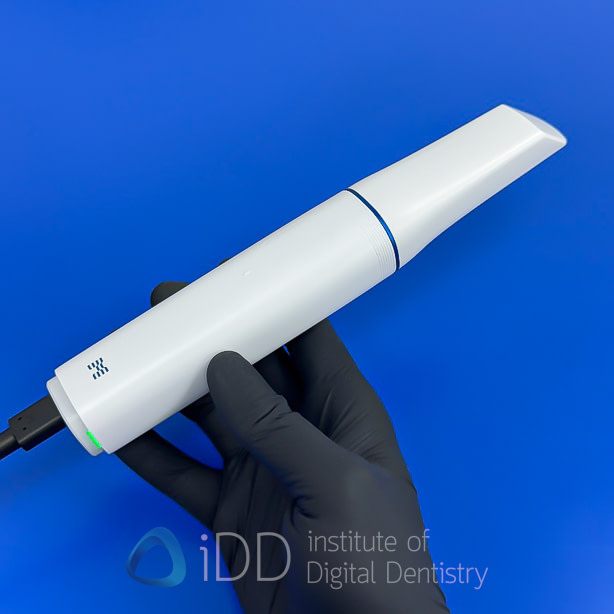
Medit's i900 combines impressive scanning speed with one of the best and most feature-rich scanner software programs on the market. Medit rocked the industry back in 2022 and this is their flagship scanner going forwards. Much smaller than all other Medit scanners and with a much larger scanner head / FOV.
- Year: April 2024
- Price (USD): $18,999
- Weight: 165g
- File formats: STL, PLY and OBJ
- Software Platform: Medit Link
Scanning Methodology
To ensure a fair and comprehensive comparison, we go through the same scanning process. I scanned the same upper 16 and lower 46 crown prep, with each IOS immediately, one scanner after the other, allowing for direct comparison across all scanners. For operator consistency I carried out all scans. Our analysis focuses on:
- Scan quality (color and monochrome)
- File characteristics (formats, sizes, mesh density)
- Clinical usability (margin clarity, overall accuracy)
I used the Medit i900 as a reference point for deviation analysis. In iDD's scientific test of all scanners, we have found the i900 to be one of the most accurate scanners on the market. The manuscript currently being written and will hopefully be published soon.
Below are the results of the individual scans - pictures of the color scan, exported STLs, tessellated mesh, and a close-up of the prep margin.
Scanning Results
Native Software Scans
Using each scanner's native software, we can examine how each device captures color (known as texture).
Color Scans
Each scanner records color differently based on how it detects light reflecting from the preparation and neighboring teeth. The software's ability to translate this data into accurate color representation also varies between systems.

Upper 16 crown prep native color scan
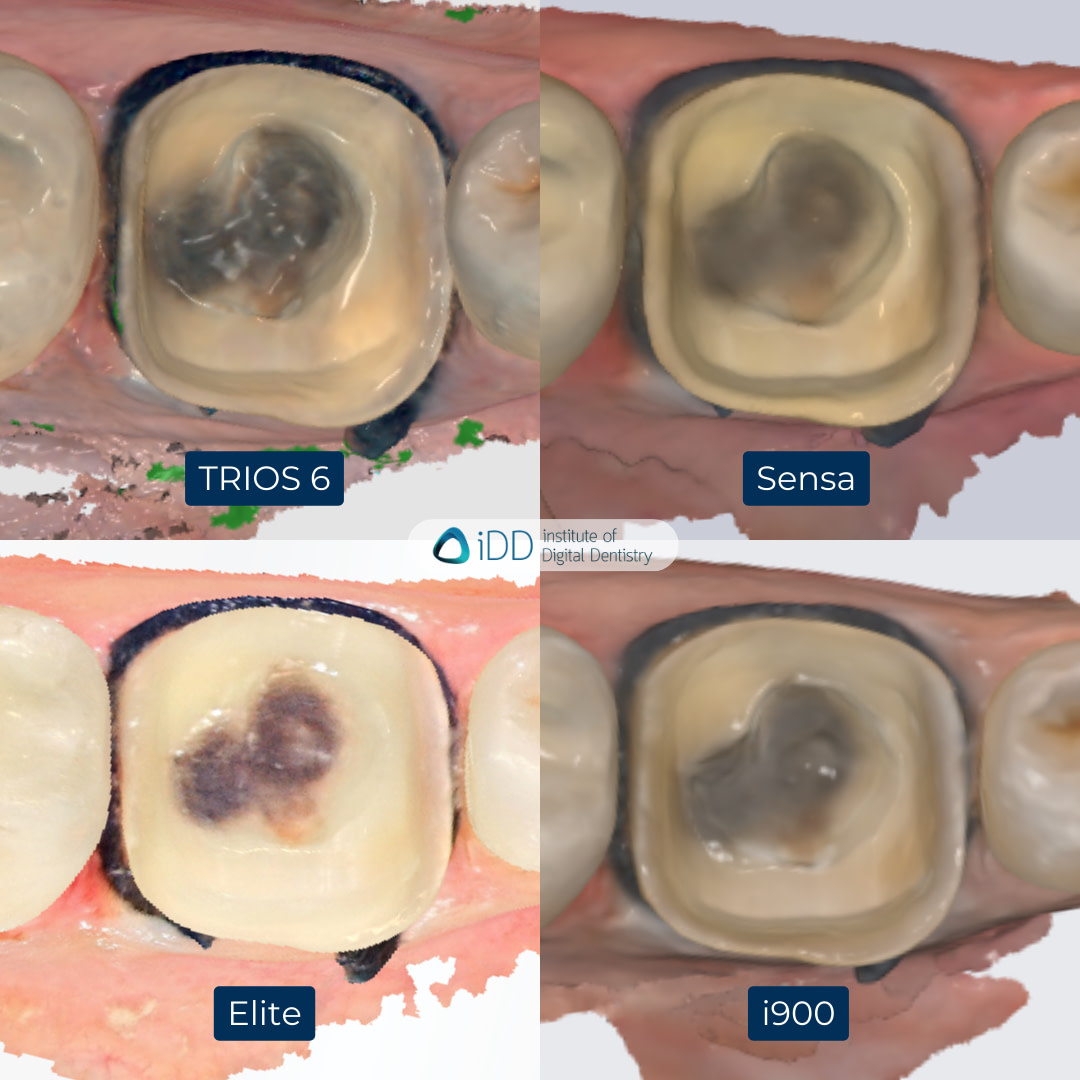
Lower 46 crown prep native color scan
Even at first glance, it is obvious that TRIOS 6 seems to capture more detail in its native scan than any other IOS. TRIOS 6’s scanning color (texture) presents a scan with a higher resolution and definition. 3Shape sayys the TRIOS 6 is the most high-resolution scanner they have made. One thing that sticks out with the TRIOS 6 is the strange 'greying' that seems to show up on the their texture mapping. This needs to improve.
The Medit i900 is less bright than the TRIOS 6 or Elite native scans. The details are great, but the sharpess seems like it is a little less than the TRIOS 6 (look at the fissures of the premolar). Textures are solid however, looking more illustrated than life-like but are consistent throughout the preparation.
SHINING 3D’s Aoralscan Elite shows a stark difference to all 3 IOS as it is the more ‘realistic’ scan. The Elite also shows a greater or higher hue, saturation and value within the scan of the crown prep as it is the brightest scan of all 4 IOS scans. This type of texture is very common with most Chinese IOS. Overall the resolution is not the highest but the details are there.
Lastly, the Alliedstar native color scan appears to have an appearance that is similar to Medit out of all the scanners. Sensa seems to have the lowest resolution out of these scanners. One thing that is fascinating is how software can change all of this significantly. This case above was scanned with an Alliedstar toggle called 'texture mapping' off. This is to make post-processing much faster but makes the textures look very basic. Below is the textures with a software toggle on and you can see a significant improvement (yet resolution of the scan remains lower).

It is important to note that the style of scan, cartoon or lifelike, does not affect the accuracy or reliability of an IOS but is up to the clinician's personal preference as to what they prefer to see and work with.
Monochrome Scans
Monochromatic scans are also available and can be viewed in each scanner's native software. Examining scans in monochrome often provides a clearer view of preparation quality and helps identify scanning issues that might not be apparent in color views.

Upper 16 crown prep native monochrome scan

Lower 46 crown prep native monochrome scan
Similar to the native color scans, the TRIOS 6 presented the most detailed morphology and clear margin lines. Medit i900 also shows excellent margin capture and consistent detail across the scan field when viewing in monochrome. Both the SHINING 3D Aoralscan Elite and Alliedstar Sensa show an acceptable amount of detail in monochrome that will likely provide clinically acceptable results, but they differ from the other two scanners.
Exported Scans
All modern intraoral scanners feature open architecture, enabling you to export the scans. Viewing these scans in third-party software allows for objective assessment without the enhancement effects of each scanner's native software. For our comparison, we used Medit Design to evaluate the detail and data quality captured by each scanner.
File Formats and Sizes
These scans are usually exported in three formats: STL, PLY, or OBJ files.
STL files are exported as monochromatic scans, whereas OBJ and PLY files store color (texture).
Not all intraoral scanners can export OBJ and PLY files, whereas STL files are widely used as the industry's default setting.

Upper 16 crown prep STL scans

Lower 46 crown prep STL scans
This particular set of scanners is capable of exporting scans in these formats:
- Alliedstar SENSA, SHINING 3D Aoralscan Elite, and Medit i900 all offer options for color and monochrome scans with STL, PLY, and OBJ file formats.
- 3Shape TRIOS 6 - STL and PLY only. No OBJ.
Upper 16 Crown Prep
Intraoral Scanner | STL | PLY | OBJ |
|---|---|---|---|
3Shape TRIOS 6 | 9.5 MB | 3.9 MB | - |
Alliedstar Sensa | 3.2 MB | 1.3 MB | 6.5 MB |
SHINING 3D Aoralscan Elite | 5 MB | 5 MB | 6.6 MB |
Medit i900 | 6.5 MB | 2.5 MB | 6.7 MB |
Lower 46 Crown Prep
Intraoral Scanner | STL | PLY | OBJ |
|---|---|---|---|
3Shape TRIOS 6 | 8.5 MB | 3.5 MB | - |
Alliedstar Sensa | 2.9 MB | 1.2 MB | 5.9 MB |
SHINING 3D Aoralscan Elite | 5.2 MB | 5.2 MB | 7 MB |
Medit i900 | 6.9 MB | 2.8 MB | 6.7 MB |
Mesh Density Analysis
The file sizes vary considerably between the intraoral scanners.
Higher-resolution scans contain more triangular facets (tessellation) to represent the 2D surface of the scanned object accurately. To objectively evaluate scan quality, we imported STL, PLY, and OBJ files into Medit Design.
The mesh density in relation to the file size seems to be:
- TRIOS 6 (most dense)
- i900
- Elite
- Sensa (least dense)
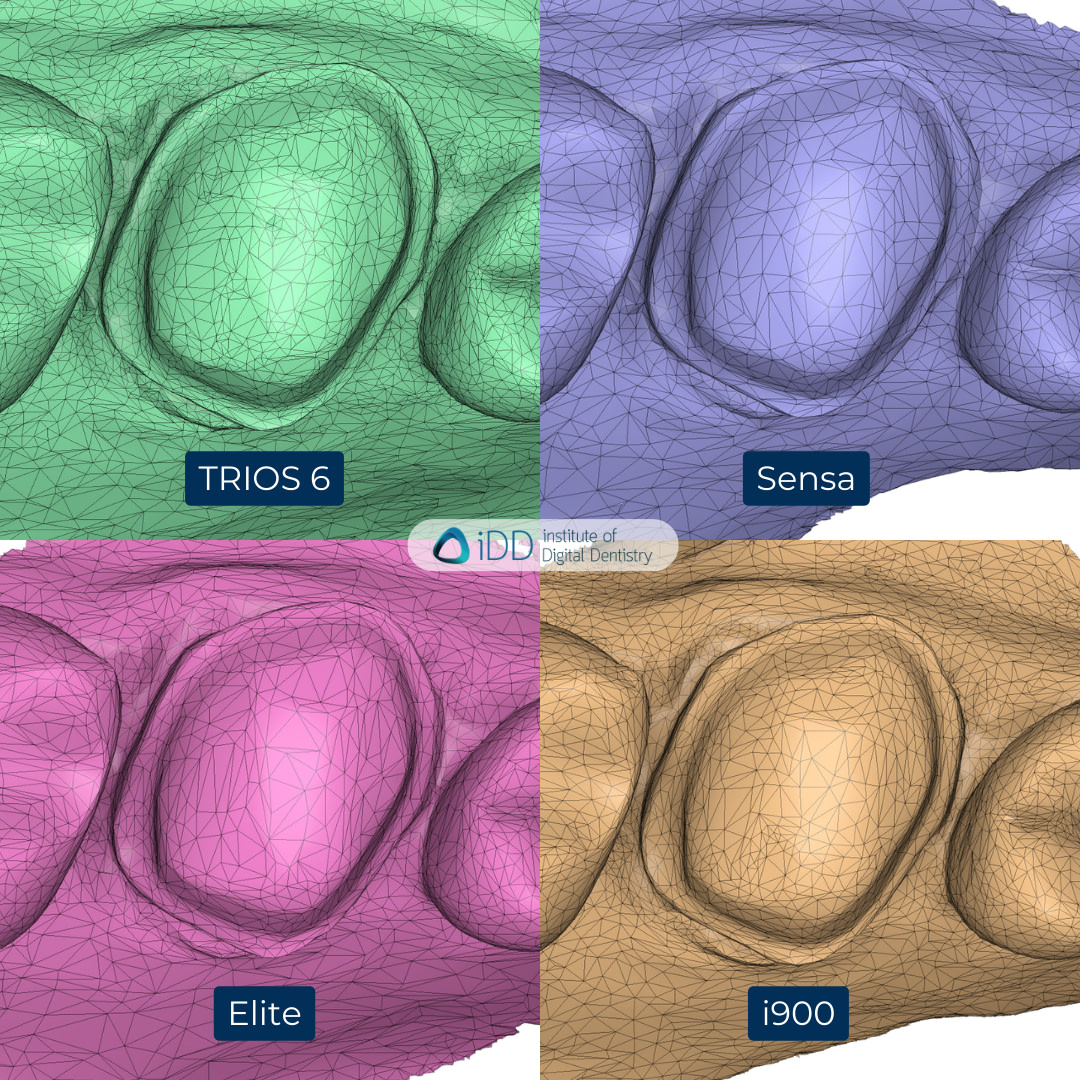
Upper 16 crown prep mesh density scans

Lower 46 crown prep mesh density scans
With the tessellation triangles in the STL scans, as previewed in Medit Design, we can see that the triangles of TRIOS 6 are densely packed. This density is closely followed by the i900. You can see the difference in the number of tessellation triangles of the TRIOS 6, Elite and Sensa. This correlates to the MB size of the STL files, as stated in the tables above.
It's worth noting that although increased mesh density can capture more detail, this doesn't necessarily translate to better accuracy or improved clinical results.
Margin Analysis
This software can also review prep margins. Clear margin capture is crucial for the fit of final restorations.
Here's how the scanners performed:
Upper 16 Crown Prep
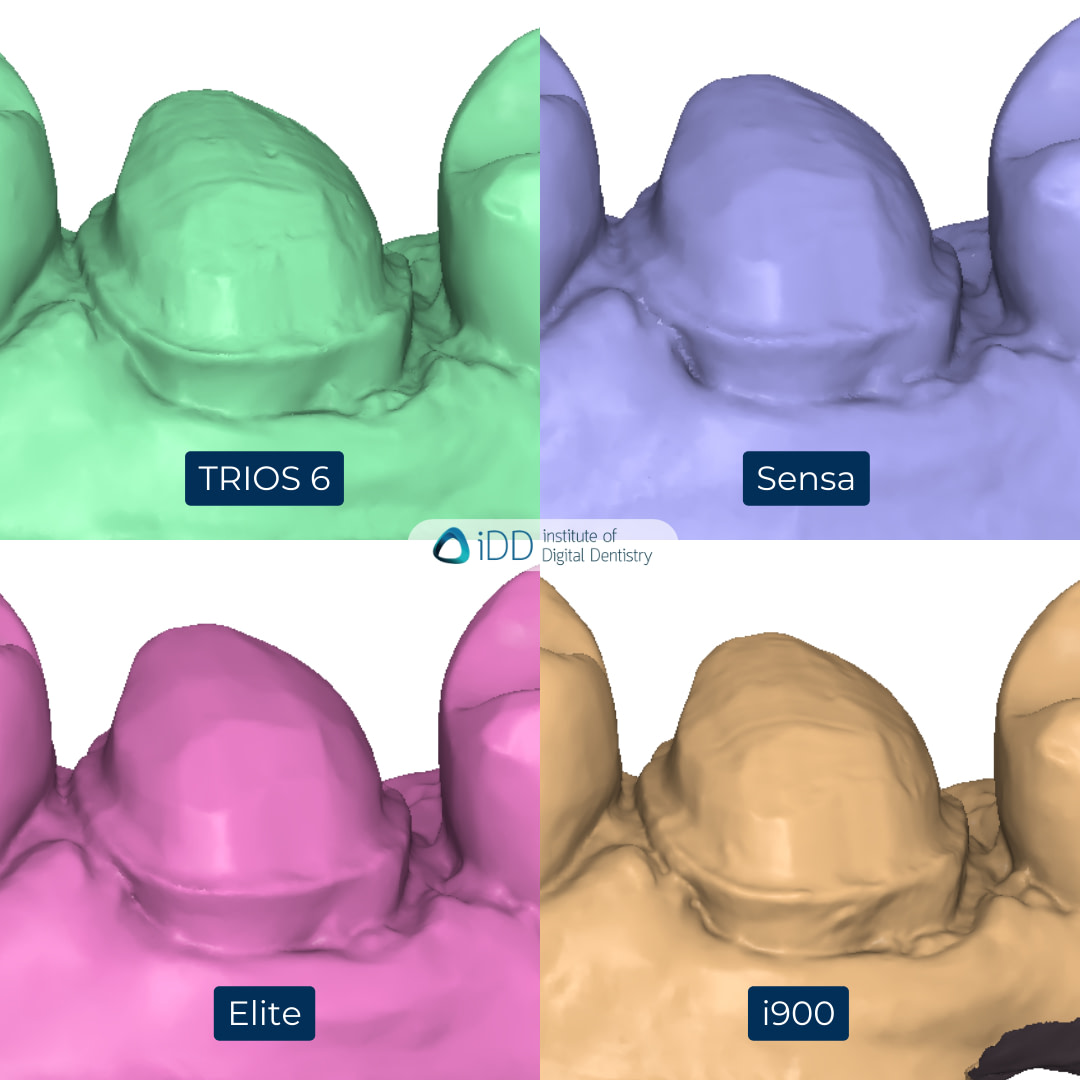
Buccal margin
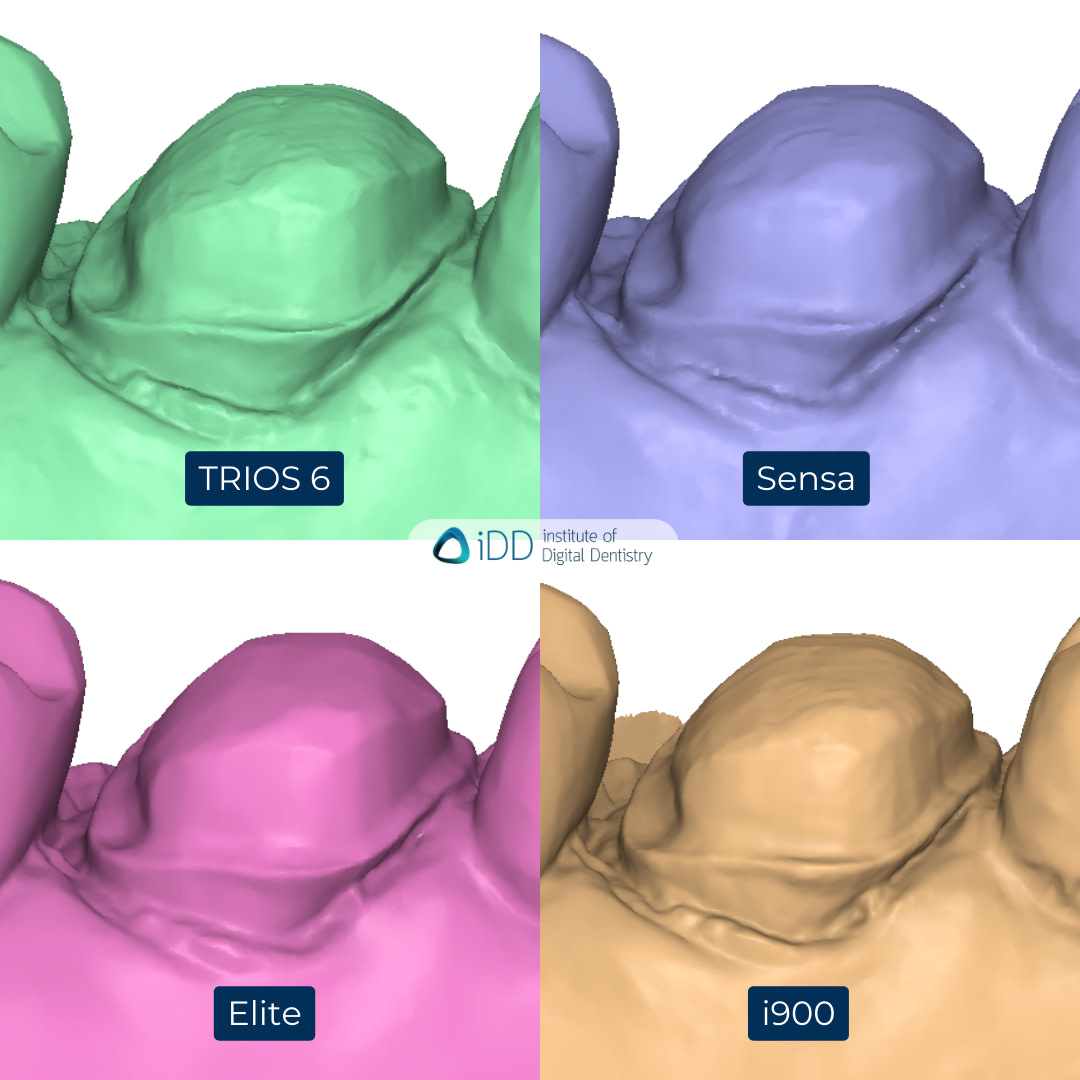
Palatal margin
Lower 46 Crown Prep
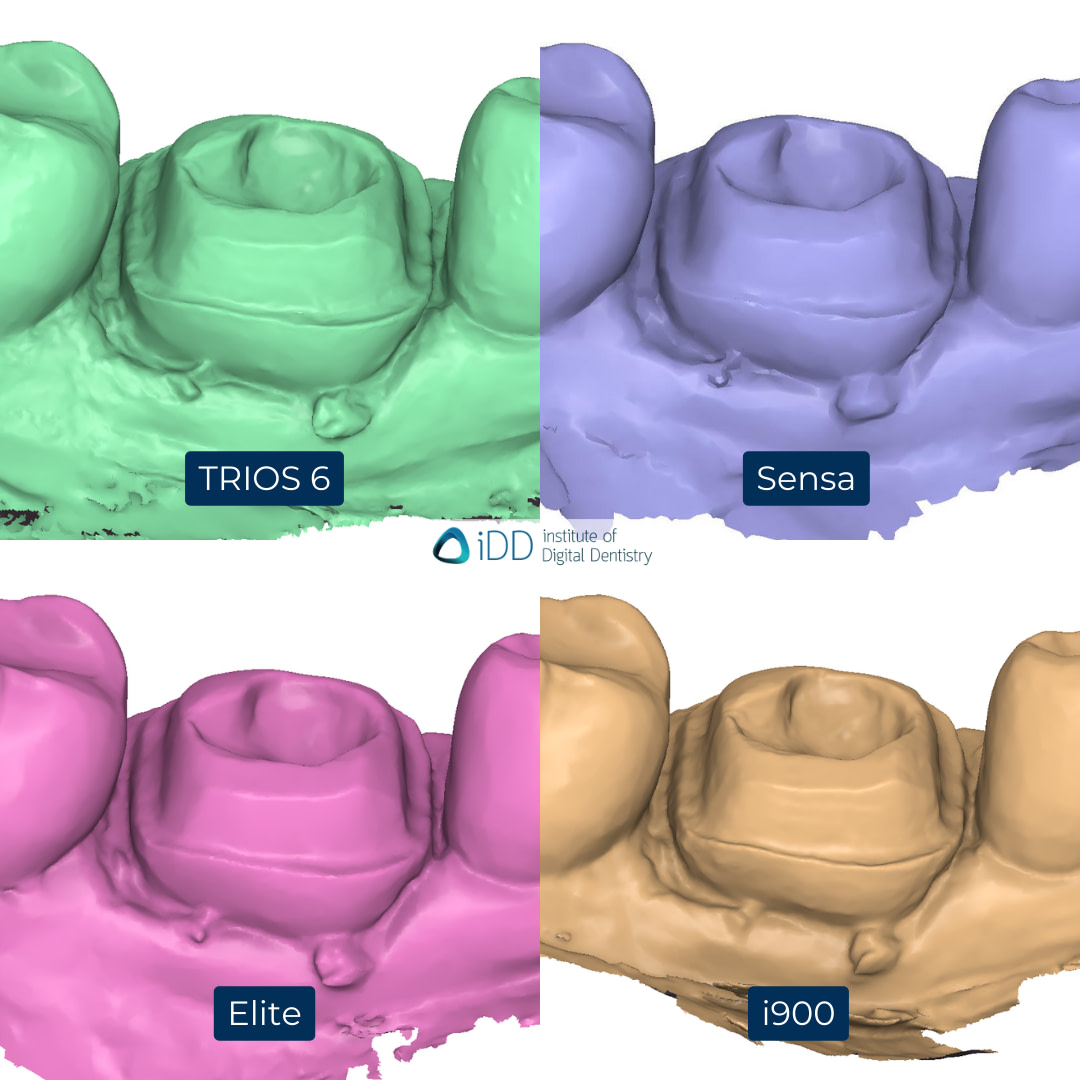
Buccal margin
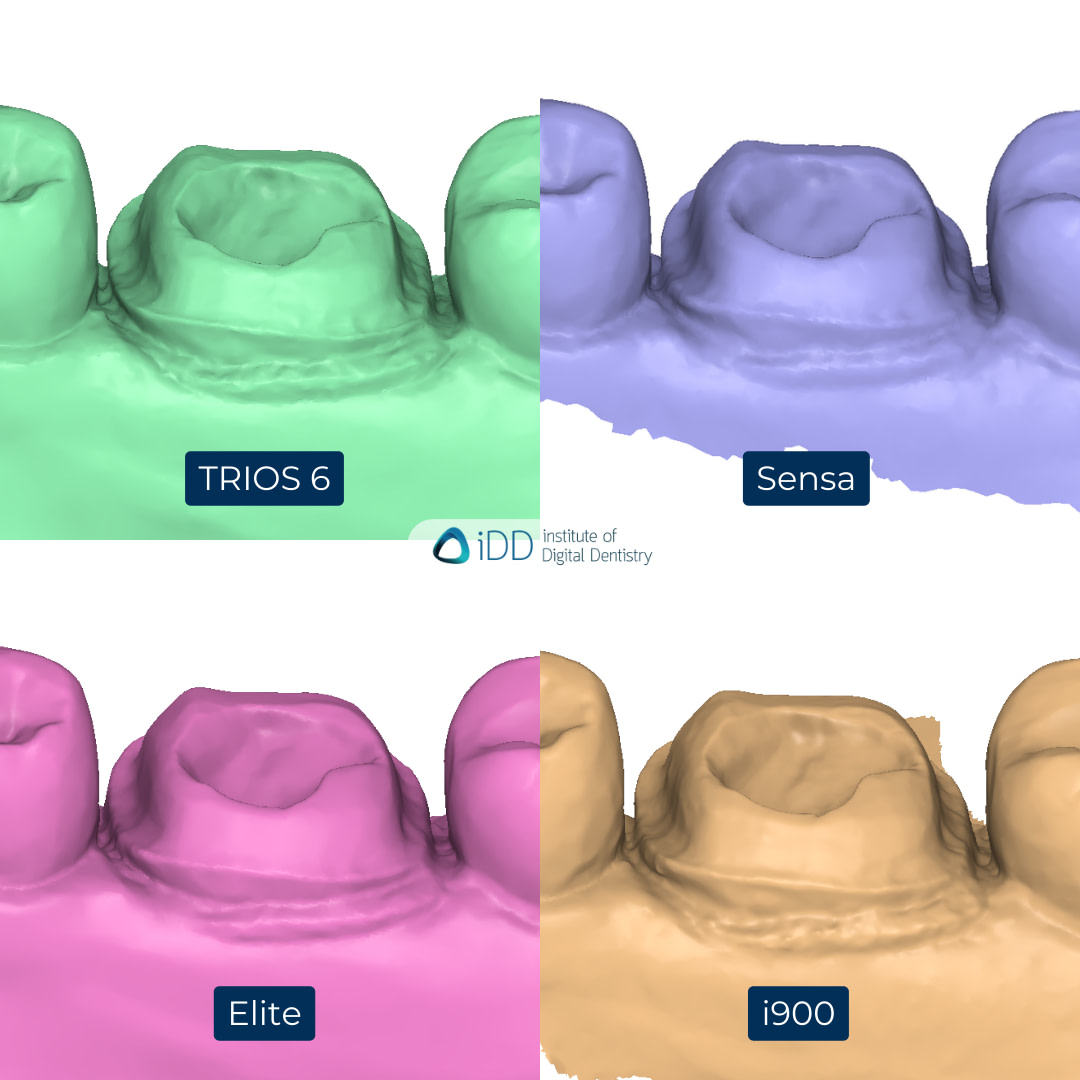
Lingual margin
Similar to our observations with the native color and monochrome scans, the TRIOS 6 captured great detail of the margin. Elite and i900 have a slightly better definition than the Sensa when looking at the margins. We could assume that the quality of a scan and margin capture seems to correlate with the scanner price, but by saying this that’s not to say that the details from a relatively less expensive IOS aren’t accurate, but they may not be as crisp in detail as a scan captured by a higher-end priced IOS.
It's also worth noting that all these intraoral scanners perform well for simple crown cases like this, delivering both speed and accuracy. Your ultimate choice will depend on your specific preferences, budget constraints, and which additional features, such as AI capabilities, you value most in your practice.
Deviation Analysis
When looking for deviations, we used the i900 as our reference point to compare all the other scanners. All scanners showed deviations within 50 microns, which is well within the range of clinical acceptability. The sectional view of the crown prep revealed minimal differences between the scans, which suggests high consistency across all devices.

Upper 16 crown prep deviation analysis
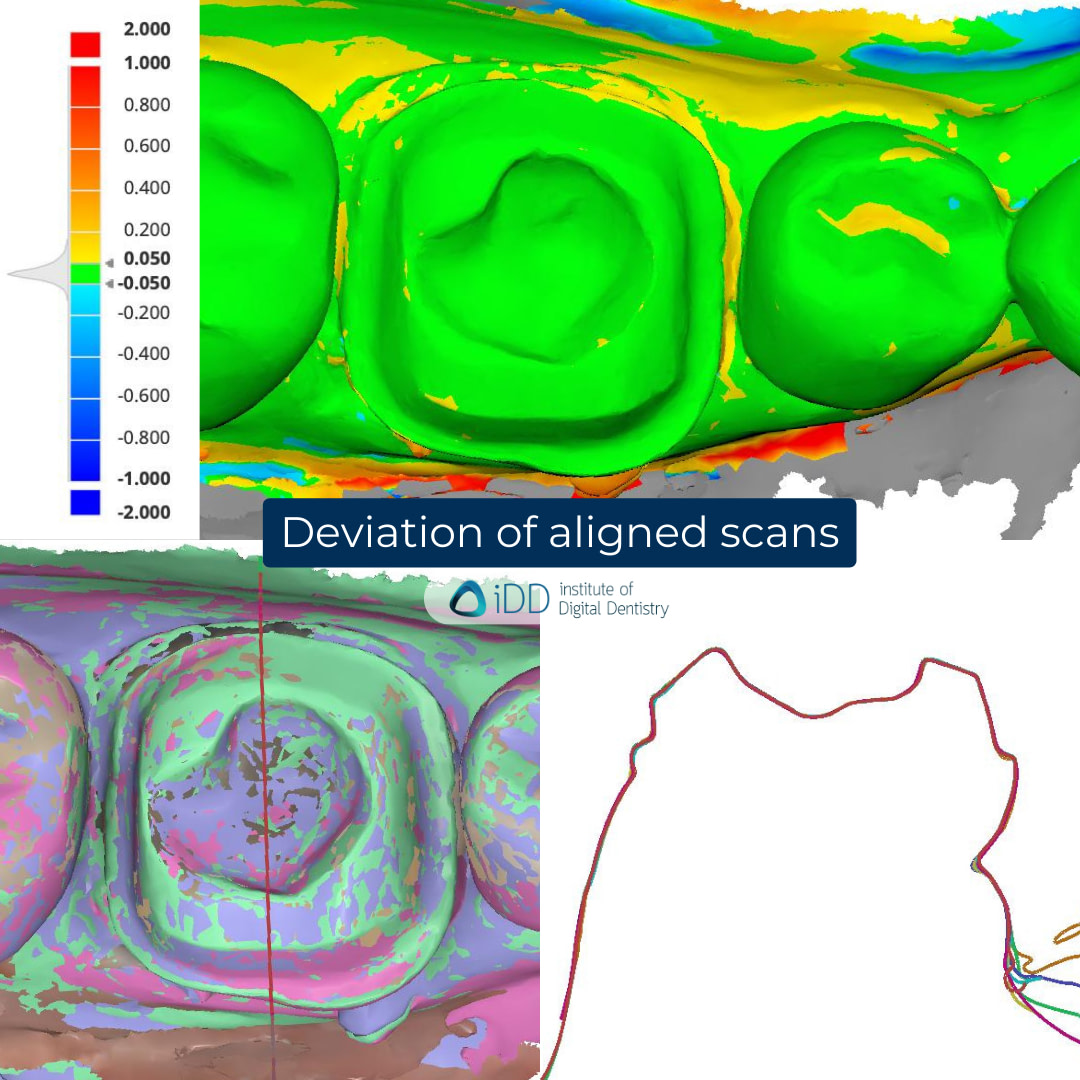
Lower 46 crown prep deviation analysis
Conclusion
You should know that basically all intraoral scanners on the market these days are 'accurate' - especially for basic indications like a single crown. So when comparing the scans, it's evident that all the scanners - 3Shape TRIOS 6, Alliedstar Sensa, SHINING 3D Aoralscan Elite, and Medit i900 - are capable of producing clinically acceptable results.
3Shape TRIOS 6 represents one of the highest resolution scanners on the market. Alliedstar Sensa offers very competitive pricing and thoughtful features like dual-sided buttons, establishing a unique selling point at its price. SHINING 3D Aoralscan Elite is a stand-out with its ultra-lightweight design and intraoral photogrammetry technology. Medit i900 continues to prove itself as an all-rounder, offering great performance and a comprehensive software suite.
Your final decision among these scanners will largely depend on your practice's specific needs, budget constraints, and preferred digital workflow. We highly recommend arranging hands-on trials through your local representatives before making your investment.
As always, let us know what intraoral scanners you’d like us to include in our next iDD Compares. Leave any comments and questions you have below, and we’ll get back to you soon. Thanks for reading and we’ll see you in our next iDD Compares!

